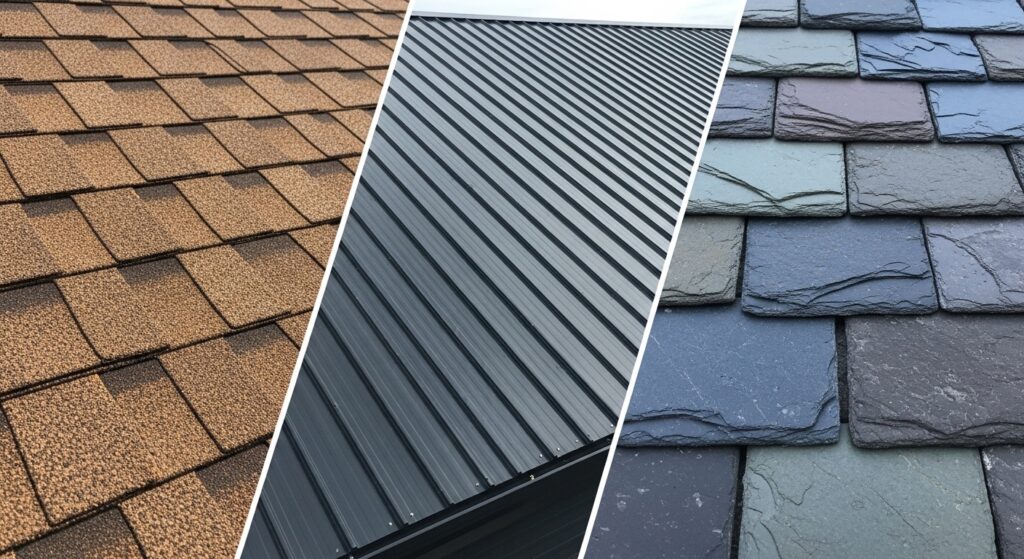When it comes to home improvement, one of the most significant decisions you’ll make is choosing the best roofing material for your property. Your roof serves as the first line of defense against the elements, and selecting the right roofing material can impact the aesthetic, durability, energy efficiency, and overall value of your home. With so many options available, it’s important to understand the pros and cons of each type to make an informed decision. In this article, we will explore some of the most popular roofing materials and provide tips on how to choose the best one for your home.
Understanding Your Roofing Needs
Before diving into the specifics of roofing materials, it’s essential to understand your needs and priorities. Ask yourself the following questions to help narrow down your options:
- What is the climate like in your area?
Some roofing materials perform better in specific weather conditions. For example, if you live in an area prone to heavy rainfall, you’ll want a material that can handle water effectively, such as asphalt shingle roofs.
- What is your budget for roof installation or roof replacement?
Your budget will play a significant role in determining the roofing material you choose. Some options, like asphalt shingles, are relatively affordable, while others, like metal or slate, can be more expensive.
- How long do you want your roof to last?
The lifespan of your roof will depend on the material you choose. Asphalt shingles typically last around 20-30 years, while other materials, such as metal or slate, can last much longer.
- What style are you looking for?
The aesthetic appeal of your roof should complement the overall style of your home. Consider the architectural design and your personal preferences when selecting a roofing material.
Popular Roofing Materials
Now that you have a better understanding of your needs, let’s take a closer look at some of the most popular roofing materials available:
1. Asphalt Shingle Roofs
Asphalt shingle roofs are by far the most commonly used roofing material in the United States. Known for their affordability, ease of installation, and variety of styles, asphalt shingles are a go-to option for many homeowners. There are two main types of asphalt shingles: 3-tab shingles and architectural shingles.
- Affordability: Asphalt shingles are generally less expensive than other materials like metal, tile, or slate. This makes them an excellent option for homeowners on a budget or those looking for a cost-effective roof replacement.
- Durability: While asphalt shingles are not as long-lasting as metal or slate, they can still last between 20 to 30 years with proper maintenance. Additionally, they perform well in a variety of climates, making them a versatile option.
- Variety of Styles: Asphalt shingles come in a wide range of colors and textures, allowing homeowners to customize their roofs to match their home’s aesthetic. Whether you prefer a traditional look or a more modern design, there’s an asphalt shingle roof style for everyone.
2. Metal Roofing
Metal roofs are becoming increasingly popular due to their durability, energy efficiency, and modern appearance. They are made from materials such as aluminum, steel, or copper, and come in various styles, including standing seam, corrugated, and metal shingles.
- Longevity: One of the biggest advantages of metal roofing is its lifespan. With proper maintenance, metal roofs can last 40 to 70 years, making them an excellent long-term investment for homeowners who plan to stay in their homes for decades.
- Energy Efficiency: Metal roofs are highly reflective, which can help reduce cooling costs during the summer months. By reflecting sunlight, they prevent heat from entering your home, keeping it cooler and reducing your reliance on air conditioning.
- Weather Resistance: Metal roofing is incredibly durable and can withstand extreme weather conditions, including high winds, hail, and heavy snowfall. This makes them a great option for homes in areas with severe weather.
- Cost: While metal roofing is more expensive than asphalt shingles, its durability and energy-saving benefits often make it a worthwhile investment. Expect to pay more upfront for roof installation, but the long-term savings in energy costs and the extended lifespan can make it an economical choice over time.
3. Slate Roofing
Slate is a natural stone material that provides a timeless, elegant look to any home. While it’s a more expensive option, it’s known for its unmatched beauty and durability.
- Aesthetics: Slate roofing offers a classic, luxurious appearance that can significantly enhance the curb appeal of your home. Its natural color variations and unique textures add character and style to any property.
- Durability: Slate roofs are incredibly durable and can last 100 years or more. They are resistant to fire, rot, and insect damage, making them a long-lasting option that requires minimal maintenance.
- Cost: Slate is one of the most expensive roofing materials available. The installation process is also labor-intensive, as each slate tile must be carefully placed. However, due to its longevity and low maintenance needs, slate can be a good investment for homeowners who plan to stay in their homes for many years.
4. Tile Roofing
Tile roofs, typically made from clay or concrete, are popular in regions with hot climates, such as the Southwest United States. They offer a distinctive look and exceptional durability.
- Longevity: Tile roofs are highly durable and can last up to 50 years or more with proper care. They are resistant to fire, insects, and rot, making them a safe and low-maintenance option for homeowners.
- Insulation: Tile roofs are excellent at insulating your home, which can help regulate indoor temperatures and reduce heating and cooling costs. In hot climates, they keep the interior of your home cooler by reflecting sunlight.
- Cost: Tile roofing can be expensive, both in terms of material costs and installation. However, their longevity and energy efficiency make them a solid investment over time.
5. Wood Shingles and Shakes
Wood shingles and shakes are a traditional roofing material made from cedar, redwood, or other types of wood. They provide a natural, rustic look that’s well-suited for certain architectural styles, such as cottages and log cabins.
- Aesthetic Appeal: Wood shingles offer a beautiful, natural appearance that blends well with natural surroundings. Over time, they develop a silvery-gray patina, which some homeowners find appealing.
- Durability: Wood roofs require more maintenance than other materials, as they are susceptible to rot, mold, and insect damage. However, they can last up to 30 years with proper care.
- Cost: Wood shingles and shakes are generally more expensive than asphalt shingles but less expensive than metal or slate. They may also require higher maintenance costs over time.
How to Choose the Right Roofing Material for Your Home
When deciding on the best roofing material for your home, keep these factors in mind:
1. Climate
Consider the weather in your area. For instance, if you live in a region prone to heavy snow, metal roofing or slate may be better suited to handle the weight of snow and ice. If you live in a hot climate, a reflective material like metal roofing can help keep your home cooler.
2. Budget
Your budget will play a significant role in determining the roofing material you choose. Asphalt shingles offer an affordable option, while metal roofing and slate are higher-end choices. However, consider the long-term value and potential energy savings when making your decision.
3. Aesthetic Appeal
Your roof should complement the overall look of your home. Asphalt shingles, slate, and metal roofing all offer different aesthetics, so choose one that fits with your home’s design.
4. Durability and Maintenance
If you’re looking for a low-maintenance, long-lasting roof, metal roofing or slate may be ideal. On the other hand, asphalt shingles are easier to repair and maintain but may need to be replaced sooner.
5. Energy Efficiency
Consider the impact of the roofing material on your home’s energy efficiency. Metal roofing, for example, can help reduce cooling costs, while tile roofing offers great insulation in hot climates.
Ready to Upgrade Your Roof?
Whether you’re considering a roof replacement, need expert roof installation, or simply want to explore the best roofing materials for your home, Prime Home Remod is here to help. Our experienced team of professionals is dedicated to delivering high-quality, durable roofing solutions tailored to your specific needs. From affordable asphalt shingle roofs to energy-efficient metal roofing, we’ve got you covered.
Contact us today for a free consultation and discover how we can help protect your home with the perfect roofing material. Get in touch with us now and start your roofing project today!
Conclusion
Choosing the best roofing material for your home involves balancing cost, durability, aesthetics, and climate considerations. Whether you’re opting for budget-friendly asphalt shingles or investing in long-lasting slate or metal roofing, the right choice will protect your home and enhance its value for years to come. Always consult with a professional roof installation contractor to ensure that your choice of roofing material is suitable for your specific needs and budget.
By understanding the options available and considering all factors involved, you can confidently select a roofing material that fits both your practical and aesthetic requirements.




